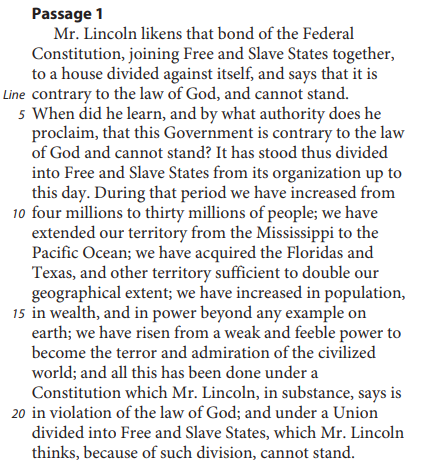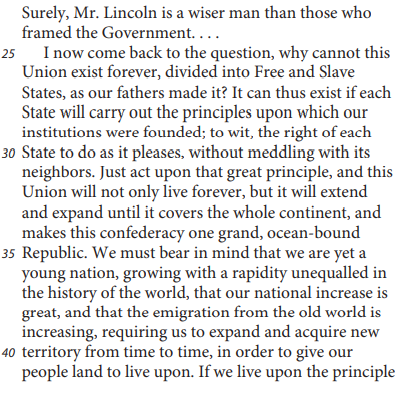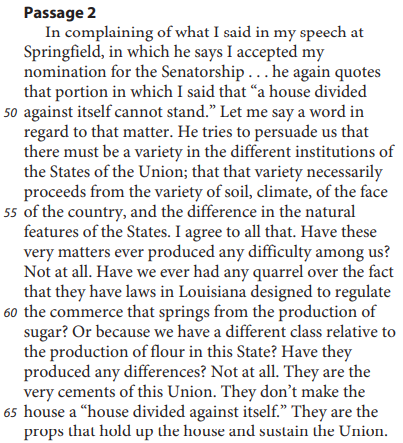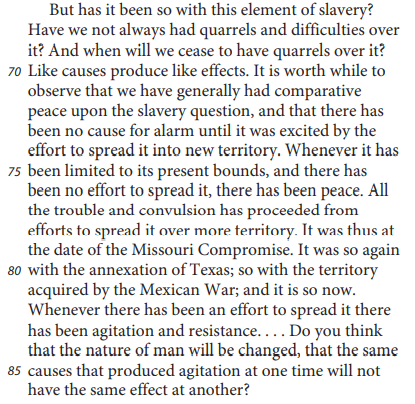SAT (Scholastic Assessment Test) is a standard test, used for taking admission to undergraduate programs of universities or colleges of the United States. SAT is developed and published by the College Board, an organization in the United States, administered by the Educational Testing Service. In this article of AKVTutorials, you will get SAT Reading Course Test 39 | SAT 2024 Online Tutor AMBiPi.
SAT Reading Practice Passage
These passages are adapted from the Lincoln‑Douglas debates. Passage 1 is from a statement by Stephen Douglas. Passage 2 is from a statement by Abraham Lincoln. Douglas and Lincoln engaged in a series of debates while competing for a US Senate seat in 1858.





SAT Reading Comprehension Practice Test Questions
SAT Practice Test 39 Question No 1
In the first paragraph of Passage 1, the main purpose of Douglas’s discussion of the growth of the territory and population of the United States is to
Option A: provide context for Douglas’s defense of continued expansion.
Option B: suggest that the division into free and slave states does not endanger the Union.
Option C: imply that Lincoln is unaware of basic facts concerning the country.
Option D: account for the image of the United States as powerful and admirable.
SAT Practice Test 39 Answer No 1
Show/Hide Answer
Option B :
In the first paragraph of Passage 1, Douglas argues that throughout the period in which the United States had both free and slave states, the nation as a whole “increased from four million to thirty millions of people . . . extended our territory from the Mississippi to the Pacific Ocean . . . acquired the Floridas and Texas . . . [and had] risen from a weak and feeble power to become the terror and admiration of the civilized world.” It can reasonably be inferred that Douglas cites such growth in territory and population to make the point that the division into free and slave states was not a threat to the country’s health or survival.
Choice A is incorrect because although it can be inferred that Douglas would argue for continued expansion of the United States, he cites the expansion it has already undergone as support for perpetuating the division into free and slave states. Choice C is incorrect because although Douglas implies that basic facts about the historical growth of the nation cast doubt on Lincoln’s political agenda, he doesn’t imply that Lincoln is unaware of those facts. Choice D is incorrect because although Douglas notes that the United States is globally perceived to be powerful, he doesn’t imply that this perception can be accounted for by the nation’s record of growth.
SAT Practice Test 39 Question No 2
What does Passage 1 suggest about the US government’s provisions for the institution of slavery, as framed in the Constitution?
Option A: They included no means for reconciling differences between free states and slave states.
Option B: They anticipated the Union’s expansion into western territories.
Option C: They provided a good basic structure that does not need to be changed.
Option D: They were founded on an assumption that slavery was necessary for economic growth.
SAT Practice Test 39 Answer No 2
Show/Hide Answer
Option C :
In the second paragraph of Passage 1, Douglas uses a rhetorical question to stress that the division into slave and free states have existed since the beginning of the United States: “I now come back to the question, why cannot this Union exist forever, divided into Free and Slave States, as our fathers made it?” It can be inferred from this question that Douglas believes that since this division is long-standing, the provisions for it in the US Constitution have provided a good basic structure that doesn’t need to be changed.
Choice A is incorrect because, in Passage 1, Douglas doesn’t observe that the US Constitution’s provisions for slavery lack a means for reconciling differences between slave states and free states. Choice B is incorrect because although Douglas stresses that the provisions for slavery are long-standing, he doesn’t characterize them as having somehow anticipated the Union’s expansion to the west. Choice D is correct because although it can be inferred from Passage 1 that Douglas believes the provisions for slavery have had a positive economic impact, he nowhere implies that the founders based them on an assumption that slavery was economically necessary.
SAT Practice Test 39 Question No 3
Which choice provides the best evidence for the answer to the previous question?
Option A: Lines 10-16 (“we have… earth”)
Option B: Lines 25-27 (“I now… made it”)
Option C: Lines 35-39 (“We must… increasing”)
Option D: Lines 41-45 (“If we… territory”)
SAT Practice Test 39 Answer No 3
Show/Hide Answer
Option B :
The previous question asks about how Douglas, in Passage 1, characterizes the Constitution’s provisions for slavery. The answer, that Douglas believes they provided a good basic structure and don’t need to be changed is best supported in the first sentence of the second paragraph of Passage 1: “I now come back to the question, why cannot this Union exist forever, divided into Free and the Slave States, as our fathers made it?”
Choices A, C, and D are incorrect because the cited lines don’t support the answer to the previous question. Instead, they describe the various ways in which the nation has expanded since its founding (choice A), stress the likelihood that the nation will only continue to expand (choice C), and assert the importance of the sovereignty of the individual states to the future expansion of the nation (choice D).
SAT Practice Test 39 Question No 4
As used in line 67, “element” most nearly means
Option A: ingredient.
Option B: environment.
Option C: factor.
Option D: quality.
SAT Practice Test 39 Answer No 4
Show/Hide Answer
Option C :
In the first sentence of the second paragraph of Passage 2, Lincoln raises a question about how the consequences of the division of the United States into slave states and free states compare with the consequences of the other ways in which states differ from each other: “But has it been so with this element of slavery?” In this context, the word “element” most nearly means factor.
Choices A, B, and D are incorrect because in the context of Lincoln’s discussion of the “element of slavery,” the word “element” most nearly means factor, not ingredient (choice A), environment (choice B), or quality (choice D).
SAT Practice Test 39 Question No 5
Based on Passage 2, Lincoln would be most likely to agree with which claim about the controversy over slavery?
Option A: It can be ended only if Northern states act unilaterally to abolish slavery throughout the United States.
Option B: It would abate if attempts to introduce slavery to regions where it is not practiced were abandoned.
Option C: It has been exacerbated by the ambiguity of laws regulating the holding of slaves.
Option D: It is fueled in part by differences in religion and social values from state to state.
SAT Practice Test 39 Answer No 5
Show/Hide Answer
Option B :
In the second paragraph of Passage 2, Lincoln asserts that the controversy surrounding slavery in the United States has died down whenever the institution of slavery has been restricted geographically: “Whenever it has been limited to its present bounds, and there has been no effort to spread it, there has been peace.” Since Lincoln associates peace on this issue with geographical limits on the institution of slavery itself, it can be inferred that he would agree that the controversy would abate if all attempts to establish slavery in new regions ceased.
Choice A is incorrect because Lincoln neither urges Northern states to attempt to abolish slavery unilaterally nor implies that such an attempt would extinguish the controversy over slavery. Choice C is incorrect because Lincoln neither suggests that the laws regulating slavery are ambiguous nor that such ambiguity exacerbates controversy over slavery. Choice D is incorrect because Lincoln never attributes the controversy over slavery to differences in religion or social values from one state to another.
SAT Practice Test 39 Question No 6
Which choice provides the best evidence for the answer to the previous question?
Option A: Lines 56-61 (“I agree… sugar”)
Option B: Lines 64-66 (“They don’t… Union”)
Option C: Lines 74-76 (“Whenever… peace”)
Option D: Lines 83-86 (“Do you… another”)
SAT Practice Test 39 Answer No 6
Show/Hide Answer
Option C :
The previous question asks which claim about the controversy over slavery would Lincoln agree with. The answer, that the controversy would abate if attempts to spread slavery to regions where it isn’t practiced were abandoned, is best supported in the second paragraph of Passage 2: “Whenever [slavery] has been limited to its present bounds, and there has been no effort to spread it, there has been peace.”
Choices A, B, and D are incorrect because the cited lines don’t support the answer to the previous question. Instead, they discuss state-to-state differences in laws regulating issues other than slavery (choice A), assert that the differences among the various states generally benefit the nation (choice B), and ask a philosophical question that doesn’t directly address the issue of slavery (choice D).
SAT Practice Test 39 Question No 7
As used in line 84, “nature” most nearly means
Option A: force.
Option B: simplicity.
Option C: world.
Option D: character.
SAT Practice Test 39 Answer No 7
Show/Hide Answer
Option D :
In the last sentence of Passage 2, Lincoln asks about the likelihood that people will fundamentally change: “Do you think that the nature of man will be changed?” In this context, the word “nature” most nearly means character.
Choices A, B, and C are incorrect because in the context of a discussion of the “nature of man,” the word “nature” most nearly means character, not force (choice A), simplicity (choice B), or world (choice C).
SAT Practice Test 39 Question No 8
Which choice identifies a central tension between the two passages?
Option A: Douglas proposes changes to federal policies on slavery, but Lincoln argues that such changes would enjoy no popular support.
Option B: Douglas expresses concerns about the economic impact of abolition, but Lincoln dismisses those concerns as irrelevant.
Option C: Douglas criticizes Lincoln for finding fault with the Constitution and Lincoln argues that this criticism misrepresents his position.
Option D: Douglas offers an interpretation of federal law that conflicts with Lincoln’s, and Lincoln implies that Douglas’s interpretation is poorly reasoned.
SAT Practice Test 39 Answer No 8
Show/Hide Answer
Option C :
In the first paragraph of Passage 1, Douglas claims that Lincoln considers the Constitution to be “a house divided against itself,” due to its provisions for the division of the nation into slave states and free states, and to be “in violation of the law of God.” In Passage 2, Lincoln objects to this characterization of his position and devotes the majority of the passage to clarify that it isn’t the Constitution he finds fault with or even its provisions for slavery, but rather with attempts to spread slavery to regions where it isn’t currently practiced. Therefore it can be said that a central tension between the two passages arises from, on the one hand, Douglas’s criticism of Lincoln for finding fault with the Constitution and, on the other, Lincoln’s insistence that Douglas has misrepresented his position.
Choice A is incorrect because Douglas (Passage 1) proposes no changes to federal policies on slavery and because Lincoln (Passage 2) doesn’t consider whether changes to such policies would enjoy popular support. Choice B is incorrect because Douglas (Passage 1) never expresses concern about the potential impact of abolition on the US economy and because Lincoln (Passage 2) neither discusses such an impact nor dismisses concerns about it. Choice D is incorrect because neither passage offers any interpretation of federal law.
SAT Practice Test 39 Question No 9
Both passages discuss the issue of slavery in relationship to
Option A: the expansion of the Union.
Option B: questions of morality.
Option C: religious toleration.
Option D: laws regulating commerce.
SAT Practice Test 39 Answer No 9
Show/Hide Answer
Option A :
In the first paragraph of Passage 1, Douglas discusses the issue of slavery in the context of the division of free states and slave states throughout the period when the United States “extended our territory from the Mississippi to the Pacific Ocean” and “acquired the Floridas and Texas, and other territory sufficient to double our geographical extent.” In the second paragraph of Passage 2, Lincoln asserts that the controversy over slavery has historically been “excited by the effort to spread [slavery] into new territory,” as in the case of Missouri, Texas, and “the territory acquired by the Mexican War.” Therefore, it can be said that notwithstanding their differences of opinion, both Douglas and Lincoln discuss the issue of slavery about the expansion of the Union.
Choices B, C, and D are incorrect because it is in relationship to the nation’s expansion that both passages discuss the issue of slavery, not about questions of morality (choice B), religious toleration (choice C), or laws regulating commerce (choice D).
SAT Practice Test 39 Question No 10
In the context of each passage as a whole, the questions in lines 25-27 of Passage 1 and lines 67-69 of Passage 2 primarily function to help each speaker
Option A: cast doubt on the other’s sincerity.
Option B: criticize the other’s methods.
Option C: reproach the other’s actions.
Option D: undermine the other’s argument.
SAT Practice Test 39 Answer No 10
Show/Hide Answer
Option D :
In the second paragraph of Passage 1, Douglas asks the rhetorical question: “why cannot this Union exist forever, divided into Free and Slave States, as our fathers made it?” The remainder of the paragraph amounts to an answer to this rhetorical question and a refutation of Lincoln’s viewpoint on slavery, as represented by Douglas. In the second paragraph of Passage 2, Lincoln asks a series of rhetorical questions: “But has it been so with this element of slavery? Have we not always had quarrels and difficulties over it? And when will we cease to have quarreled over it?”These questions imply that there are flaws in Douglas’s equating the division into slave states and free states with other, more unambiguously beneficial differences from state to state. The remainder of the second paragraph expands on these flaws. Therefore, it can be said that in context, the rhetorical questions asked by each speaker serve to undermine the argument of the other speaker.
Choice A is incorrect because in asking rhetorical questions, neither Douglas nor Lincoln casts doubt on the sincerity of his opponent. Choices B and C are incorrect because although Douglas and Lincoln find fault with each other’s ideas, they don’t criticize each other’s methods (choice B) or reproach each other’s actions (choice C).



